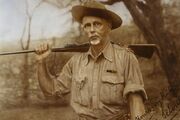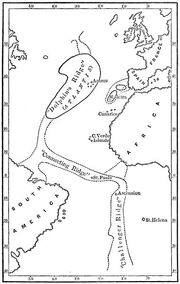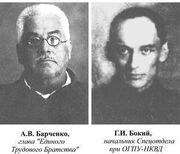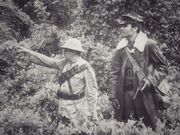Pulp is a literary and artistic genre of the early 20th century that encompasses many subgenres of literature, especially horror, detective and science fiction. However the "adventure" subgenre also had a significant impact, drawing inspiration from the "Lost World" fiction and non-fiction explorer literature.
The core of this aesthetic is perhaps the Indiana Jones franchise, which, beginning in early '80s, started as a tribute to the existing genre; the character of Indiana Jones was created as a pastiche of such heroes and historical figures, but in turn also redefined, revitalised and popularised the aesthetic in modern times, and spawned other tributes and ripoffs.
The roots of the aesthetic are older and can be traced to the western colonialism, and represents a Victorian's romanticised perception of the Exotic. In a historical context, protagonists of the tradition were hardened western explorers, archeologists, hunters, officials, and even spies, who served and operated in Africa, "the Orient" (Asia and the Middle East), and the Amazon to contact other cultures and even primitive tribes. Those historical personalities had multidisciplinary background in many languages, cultures, history, engineering, wildlife, and nature.
The limited knowledge and understanding of history and these undiscovered regions- and the high amount of superstition and pseudoscience prevailing in the era- gave to these stories a larger-than-life aura of mystery. Pseudohistorical and supernatural elements are common in fiction; even more recent works portray a highly fictionalised version of real-life locations and figures. Egyptian mysticism, curses, shamanism, out-of-place objects, ancient aliens, and extraterrestrial or Atlantean technology, are frequent tropes.
History[]
Weird though it may sound (and on the other hand, quite fitting) the ancestor of perhaps all explorer/adventurer/archaeologist/egyptologists was an ancient Egyptian himself: Prince Khaemweset. He traveled around Egypt, visiting ancient temples and tombs of earlier dynasties, making restorations and rediscovering forgotten lore. After his death, his exploits were remembered in legendary literature; in one of those stories, which could have come out of a pulp magazine, he was seeking the lost "Book of Thoth" to augment his magic powers. He discovers it in an ancient tomb, but he ignores the warnings of the tomb's occupant, and is punished by its curse.
Historical context[]
In the beginning there was the Age of Discovery, which resulted to the Golden Age of Piracy and Colonization. The cruel conquistadors, when not slaughtering the natives and destroying their culture, heard some tales about "lost cities" with treasures and gold, and made (non-archaeological) expeditions to find them, fueled by lust and greed. This was the origin of El Dorado. Francisco de Orellana was the first to explore the Amazon river, which he documented; its name is credited to him, after fighting the Tapuyas, whose women he compared to the Amazones of classical literature.

So, imagine you are a 19th-century Swiss man, surviving among the bedouins, and eventually get to be the first European to see this.
In the dawn of the 19th century Johann Ludwig Buckhardt worked for the African Association and travelled up to Syria. Having adopted arabic language, customs and appearance, he merged into the locals and thus learned about the "lost city" of Petra, unknown to the West. After surviving several adventures such as treacheries and robberies, he discovered it and returned to document it.
The Victorian era coincided with the New Imperalism period of colonial expansion and the "Scramble for Africa" phenomenon. In that context, western colonial adventurers roamed the then-wilder portions of the world of Africa, the Middle East and the Americas; those were explorers, expeditioners, journalists, soldiers, spies, missionaries, archeologists, aviators, scentific investigators. Some of those individuals were not only heroic, but often polymaths who possessed diverge overlapping disciplines, and operated on a number of diverse but interconnected levels.

Frederick Selous in Africa
One of the most exemplary of those figures was Sir Richard Francis Burton (1821 – 1890) who, inspired by Buckhardt's adventures, became famous for his explorations in Asia, Africa, the Middle East, and the Americas, and the literary works he authored or translated. Another legendary figure was Dr. David Livingston, missionary and explorer; with the ambition to discover the sources of the Nile River, and stop the East African slave trade, he became the first European to cross south-central Africa, and led the Second Zambesi Expedition to examine the natural resources of southeastern Africa. Meanwhile, journalist Henry Morton Stanley organised an expedition to the Ottoman Empire, accompanied a force to Ethiopia to release British hostages, reported on a Battle in Abyssenia, and visited Persepolis in Iran, before famously "rescuing" Dr. Livingstone. He then led an exploration of central Africa.
Dr. Livingstone's exploits influenced young Frederick Selous, who since his childhood dreamed of going to Africa and become a big game hunter. He became a celebrated hunter, conservationist, explorer, and British army officer, leading expeditions, contacting unknown tribes, and participating in the Matabele Wars. Selous, along with Frederick Russell Burnham became the inspiration for the archetypal action-adventure pulp hero: Allan Quatermain.

Explorer and archeologist Alfred Maudslay at his 'office', the ruins of Chichen Itzà
In other parts of the world, in the turn of the century, Western adventurers explored and discovered fascinating remnants of "lost" civilizations all around the world: from the Valley of the Kings in Egypt, the ruins of mythical Troy in Turkey, Minoan palaces on Crete, Greece, and the remnants of the Assyrian empire. On the other side of the globe the "lost city" of Machu Picchu was found, as well as Mayan pyramids shrouded in the jungle. Such stories, and their finds captured the imagination of the public opinion, and wondered about the still-unexplored wild regions of the world and what they would hide. This gave rise to the "Lost World" genre of fiction.
Father Abbé Charles-Étienne Brasseur de Bourbourg, a French priest, writer, ethnographer, historian, archaeologist. While a student he started writing essays in local folklore and historical accounts, gaining a reputation as a young writer and intellectual, although he always would be accused for plagiarisms and inaccuracies. After his ordination as a Catholic priest he made many travels to Central America as a missionary (1848). He was fascinated by the antiquities and little-understood monuments, and learned the history of the region (what was known then) and the indigenous languages. In 1864 he joined the French military expedition in Mexico as an archeologist.
He published a history of the Aztec civilization, based on what was known/speculated about them, translated the mayan sacred text Popol Vuh, along an essay on mayan mythology and a grammar of the K'iche' dialect. In Madrid, he came across a copy of a manuscript written 300 years earlier by the Spanish cleric Diego de Landa, where he attempted to transcribe a "Mayan alphabet". Brasseur republished it, hoping that it would be the basis of deciphering the then-mysterious Mayan hieroglyphs. His work was significant in the preservation and divulgation of the language and history of the Aztecs and Mayans, but he was also responsible for fanciful theories...
Stranger than fiction[]
The first second half of the 20th century, the lines between science, spiritualism and mysticism was blurry. Many scientists, including archeologists and travelers, were superstitious; furthermore they weren't as much interested in accuracy, as leaving an impression with sensational stories. Some early theories were fueled by religious interpretations, as the Mesoamericans or the Pacific islanders were seen as the Lost Tribes of Israel.
An early such figure can be found in the French antiquarian, artist and explorer Jean-Frédéric Maximilien de Waldeck (1766? – 1875) who valued his self-promotion and "a good story" more than truth. He lied about his place of birth and citizenship, claimed to be a noble (from Baron to Duke) and that he travelled to S. Africa and Egypt with Napoleon's expedition.
While stıll in Europe he was hired to work on some engravings for an older report on Palenque. For some reason he chose to reproduce them fancifully with some Egyptian look. When he eventually left for Mexico, he participated in its exploration, making the ruins of Palenque, Mérida, Yucatán and Uxmal his home. His illustrations and architerctural reconstructions of the Aztec and Mayan ruins and sculptures followed the same philosophy of suggesting the connections between Mexico and Egypt.
Father Brasseur had similar views: he perceived similarities between K'iche' Mayan and Old World languages; he thought that America was the origin of all languages, and Atlantis, a prehistoric advanced civilization, was the link of a trans-Atlantic contact. Brasseur also also believed that the Mayans continued the lost culture of Atlantis and sought a common link between Egyptian and Mayan mythologies. Using Mayan historiography he wrote a speculative history of Atlantis.

Map of Atlantis according to I.L. Donnelly's Atlantis and the Antediluvian World
The two, Brasseur and Waldeck "met" when the latter's illustrations accompanied the former's texts. This time Waldeck's reconstructions were embelished with Greco-Roman influences (and the way he adapted the mayan scripts he erroneously included heads of elephants). One more influence from Brasseur came after examining an old codex which he identified as Mayan. In his tentative attempts of translation (partially "helped" by the innacurate de Landa's alphabet) he identified the name "MU". In his last article (1872) he advanced the theory that shifts of the Earth's axis resulted to four cataclysmic periods from 10,500 BC.
In 1908 the Church of England appointed Frederick Bligh Bond director of excavations at Glastonbury Abbey. Bond was a Freemason and member of the Theosophical Society and the Society for Psychical Research. He claimed that the retired navy Captain "John Alleyne" contacted dead monks and the builder of the Edgar Chapel at Glastonbury, who advised him where to excavate, discovering the nature and dimensions of some buildings. The Church strongly disapproved of spiritualism and Bishop Armitage Robinson dismissed him in 1921.

Barchenko and Bokii, leaders of the Soviet expedition to discover Shambhalla in the depths of Asia. I guess some bullwhip-wielding Fedora-wearing archaeologist was sent to foil their plans.
In the early 1920s the Bolshevik Gleb Bokii (chief cryptographer and officer of the Soviet secret police), was inspired by Theosophical teachings and Tibetan traditions and experimented with Buddhist spiritual techniques for "engineering perfect communist human beings". With his friend Alexander Barchenko, a writer and researcher of "anomalous phenomena", known for his researchings of Hyperborea in Russian Far East, they embarked on a quest for the mythical realm of Shambhala to retrieve its wisdom. Intrigues within the Soviet intelligence service put an end to the expeditions, while the Foreign Commissariat sent its own expedition to Tibet in 1924.
F.A. Mitchell-Hedges was a famous but controversial adventurist. In Mexico he was captured by Pancho Villa and worked as a spy. His curiosity for travel and discovery grew because of his interest in the lost city of Atlantis. He considered the Bay Islands of Hondoura the remnants of Atlantis, and that the Mosquito Coast of Nicaragua was the "cradle of civilization". His finds are in question, and his most controversial, about which he is most famous, is the Crystal Skull of Doom; his daughter claimed that she discovered it in 1924 in a Mayan temple in Lubaantun, under a collapsed altar (documental evidence suggested that her father bought it much later from an art dealer); the adventurer claimed that it was more than 3.600 years old and had supernatural powers in the hands of a Mayan priest.
Fashion[]

Hiram Bingham, discoverer of Machu Picchu.
- Leather jacket
- Extraneous equipment such as compasses, knives, flashlights
- Notebooks and diaries
- Combat or hiking boots
- Scarf
- Cloaks, long coats
- Pocket watches
- Reusable metal lighters
- Satchel
- Machete

Two cosplayers in period attire, posing for an adventure that only our imagination can tell.
Cosplayers might wear more impractical and period-specific accessories pointing to the Victorian or interwar era such as:
- Fedora, Panama or Newsboy hats
- Glasses and monocles
- Pith helmets
- Whip
- Moustache and sideburns
- Short pants
- Sleeveless tank top
- Pipe, cigars
Media[]
Films[]
- The African Queen (1951)
- Secret of the Incas (1954)
- Indiana Jones series (1981-2023)
- Romancing the Stone (1984) and The Jewel of the Nile (1985)
- The High Road to China (1985)
- Rudyard Kipling's The Jungle Book (1994)
- The Mummy trilogy (1999-2008)
- Atlantis: The Lost Empire (2001)
- Sky Captain and the World of Tomorrow
- King Kong (2005, especially the first half)
- Kon-Tiki (2012)
- The Lost City of Z (2016)
- Jumanji: Welcome to the Jungle (2017) and The Next Level (2019)
- King Kong: Skull Island (2017)
- Jungle Cruise (2021)
- Uncharted (2022)
- Strange World (2022)
(Despite their reputation, the Tomb Raider movies with Angelina Jolie are not representative)
TV Shows[]
- Tales of the Golden Monkey
- Ducktales
- The Young Indiana Jones Chronicles (1992)
- TaleSpin
- Relic Hunter
- The Librarians
- The Lost World (1999)
- Adventure Inc. (2002)
- Bonekickers (2008)
- Danger 5 (2012)
- Hooten & the Lady (2015)
- Expedition Unknown (2015)
- Archer Season 9: Danger Island
Board Games[]
- Curse of the Idol
- Escape: Curse of the Temple
- Lost Cities
- Lost Ruins of Arnak
- Jumanji
- The Quest for El Dorado
- RPG settings:
- White Wolf's Adventure!,
- West End Games's Torg (Nile Empire, Terra, The Land Below sourcebooks),
- Steve Jackson Games's GURPS Cliffhangers (High-Tech, Atomic Horror, Planet of Adventure, Psionics, Bestiary, Dinosaurs)
Video Games[]
- Pitfall series
- Zak McKracken and the Alien Mindbenders
- Rick Dangerous
- Worlds of Ultima: Savage Empire
- Indiana Jones games
- Heart of China
- Amazon: Guardians of Eden
- Flight of the Amazon Queen
- Bermuda Syndrome
- Tomb Raider series
- Amerzone
- Uncharted
- Deadfall
- Earthlock
- Call of the Sea
Literature[]

Itinerary literature surrounded by exotic props.
Non-fiction[]
- John Lewis Burckhardt, "Travels in Arabia" (1829)
- John Lloyd Stephens, "Incidents of Travel in Yucatan" (1843)
- F.A. Ober, "Travels in Mexico"
- Charles John Andersson, "Four years in the wilds of Africa" (1861)
- Guillaume Lejean, "Le Tour du Monde" (1867)
- Amelia B. Edwards, "A thousand miles up the Nile" (1873)
- E.G. Squier, "Peru Incidents of Travel" (1877)
- G. Ebers, "Picturesque Egypt" (1885)
- Henry Morton Stanley, "In darkest Africa" (1890) and "Explorations and Adventures"
- Percy Fawcett, "Exploration Fawcett" and "Lost Trails, Lost Cities"
- Frederic Selous, "Travel and Adventure in South-east Africa" (1893) and "Newfoundland Guide Book" (1905)
- Edith Wharton, "In Morocco" (1920)
- James Norman Hall, "Faery Lands of the South Seas" (1921)
- Lady Richmond Brown, "In Unknown Tribes: Uncharted Seas" (1924)
- Thomas Gann, "The history of the Maya" (1931)
- F.A. Mitchell-Hedges, "Land of Wonder and Fear" (1931) (although the book is presented as an autobiographical account in Central America, some consider it nonsense)
- Thor Heyerdahl, "Aku-aku, the Secret of Easter Island"
- Caroline Mytinger, "Headhunting in the Solomon Islands" (1941)
- William Carlsen, "Jungle of Stone"
Fiction[]
- Operator #5
- The Adventures of Smilin' Jack
- Doc Savage
- Allan Quatermain
- Tintin
- Blake and Mortimer
- Scrooge McDuck adventures by Carl Barks or Don Rosa
Pseudohistory[]
Various ancient and pre-modern literature represent an alternate romantic, semi-mythical view of the unknown world, which influenced later pseudohistorical literature and fiction.
- Iliad and Odyssey
- History of the Kings of Britain and Arthurian literature
- Oedipus Aegyptiacus and Lingua Aegyptiaca Restituta by Athanasius Kircher
- Atlantis and the Antediluvian World by I.L. Donnelly
- The Lost Continent of Mu, the Motherland of Men (1926) by James Churchward, and sequels
- Story of Atlantis and the Lost Lemuria (1925) by Wlliam Scott-Elliot
- The Occult Roots of Nazism
- Lost Continents by L. Sprague de Camp
Music[]

06 - Bermuda Syndrome Soundtrack - Jungle-2
Music track from the Lost World-themed video game Bermuda Syndrome.
There is no music closely associated to the adventurous pulp genre, however the soundtracks of the above media can contribute. The Indiana Jones soundtrack for example is characterized by uplifting marches and fanfares. Tribal and ethnic music can also give further shape to the aesthetic. Querying YouTube keywords such as "lost world temple jungle adventure music" can yield interesting results.
Activities[]

Portrait of Sir Richard Burton (1821 – 1890) famous as the first western explorer who reached Mecca, and for his extraordinary knowledge of languages and cultures. An archetypal adventurer-scholar, Wikipedia mentions him as an explorer, geographer, writer, soldier, orientalist, cartographer, ethnographer, ethnologist, diplomat and spy; he was also a linguist, polyglot (spoke 29 languages), translator and writer of poems and books.
Both the historical figures who originated the aesthetic, and the characters of adventure pulp fiction are polyglots and polymaths with a rich background from academia to hard adventuring and survivalism. The character of Doc Savage, a typical pulp hero, fits the competent man archetype: he can pilot an airplane, survive in the jungle, decipher Mayan hieroglyphs, communicate with an uncontacted Amazon tribe, even foil the plans of an evil Nazi or Soviet scientist.
As a result the "adventure pulp"-related hobbies can be widely diverse, from scholarship to the extreme outdoors.
- Scouting and camping
- Exploring and documenting (eg. wildlife)
- Mountaineering
- Jungle hiking
- Safaris
- Identifying wildlife and tracking animals
- Game hunting
- Treasure hunting
- Shooting sports
- Martial arts
- Traveling documentaries
- Aviation
"Academic" interests[]
- See also: Cryptid Academia, Dark Academia, Green Academia, Light Academia
- Pop archeology and pseudoarcheology
- History and pseudohistory
- Partially the paranormal and forteana where they cross over to exploration, lore and archeology. Focus on alchemical texts, cryptids, the Templars, ancient aliens, curse of the pharaohs.
- Legendary or mysterious artifacts in history and lore, like Excalibur, holy relics, "cursed objects", mysterious out-of-place artifacts like the crystal skulls etc.
- History of the World Wars or the Cold War, specifically the less known aspects (conspiracy theories, espionage, secret technology, psychic experiments, Nazi occultism)
- Anthropology, folklore and mythology
- Studying/learning ancient and "exotic" languages, runes and hieroglyphs
- Egyptology
- Mayanism
- Studying maps and constellation charts; including outdated/inaccurate maps depicting phantom islands or legendary locations (eg. the kingdom of Prester John)
- Reading and studying authentic literature (classical epics, medieval romances, renaissance "scientific" or alchemical works)
- Cryptozoology
Resources[]
External Links[]
- Lost world on Wikipedia
- Pulp magazine on Wikipedia
- Men's adventure on Wikipedia
- In Genre: MODERN PULP ADVENTURE on rpg.net
- Society of Explorers and Adventurers on S.E.A. Wiki
- TV Tropes:
Film lists[]
Please note that those lists greatly overlap, and titles are repeated between each other. Perhaps a more concise list should be made.
- Welcome to the Jungle
- Pulp inspiration
- Pulp movies: superhero and adventure
- Classic Pulp and Noir Worth Watching (ignore the "Noir" ones)
- Treasure Hunters & Glory Seekers
- Archaeological
- Archaeological adventurers
- Arcaheological movies
- Archaeology, lost world or reasure hunting
- The great explorers & the Lost Worlds
- Archaic & ancient mystery
- Lost World
- Dieselpunk movies
- Indiana Quatermain and the rip-offs of doom
- Indiana Jones influences
- Indiana Jones inspirations
- Indiana Jones alike movies
- Indiana Jones lookalike
- Indiana Jones Legacy
- Indiana Clones
- 500 Indiana Jones/Treasure of the Sierra Madre Type Movies & Shows
- Indiana Jones exploitations
- Indy Jones by Alex Smile
- Adventure!!
